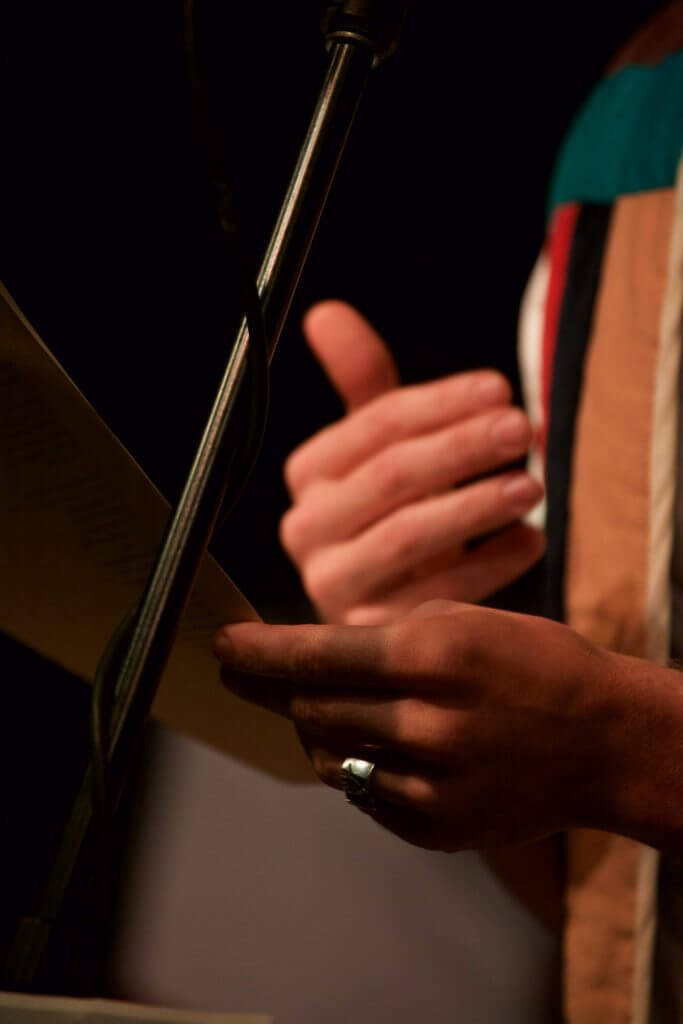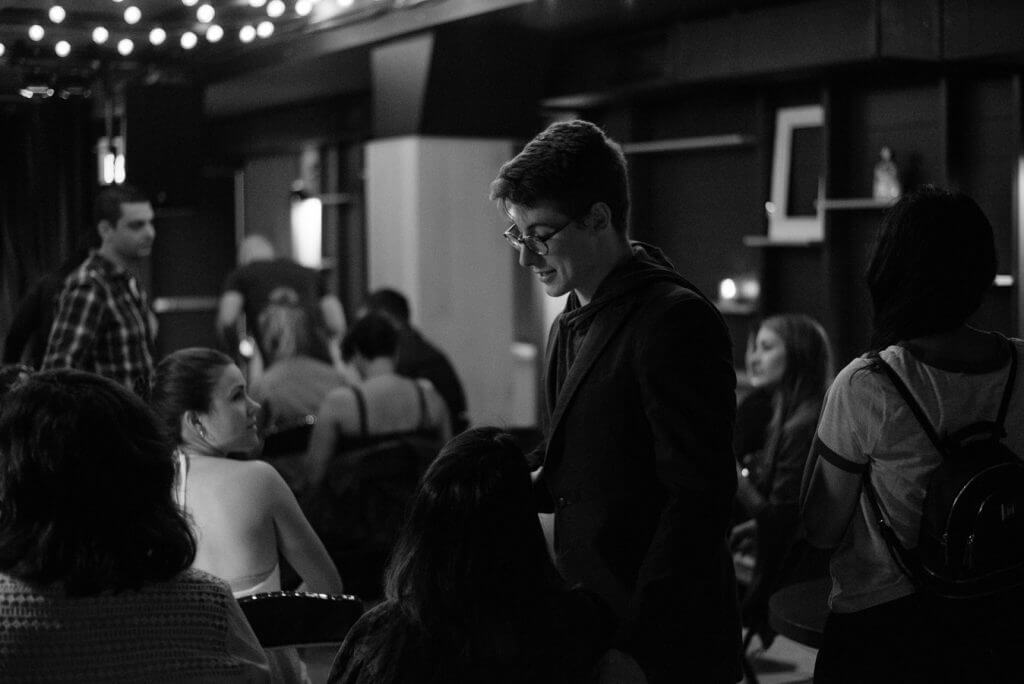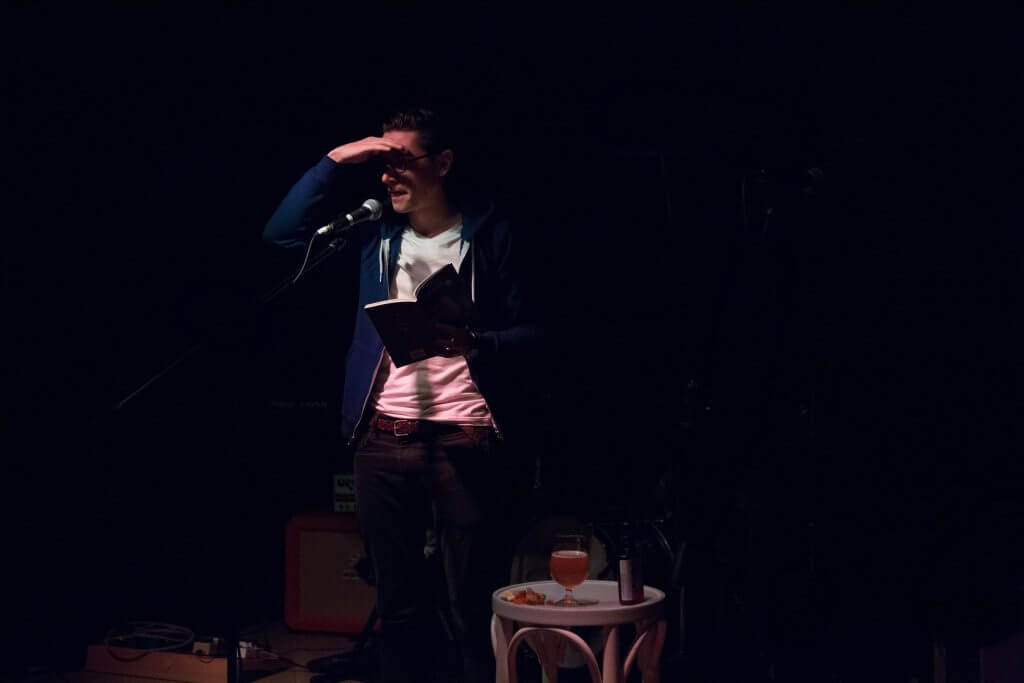Want to be part of Toronto’s art scene? New monthly event encourages emerging artists to join in
The Slackline Creative Arts Series creates a welcoming environment for newbies
Allyson Aritcheta@ariCheddar

Photo by Yonah Obadia.
The seating area of the Burdock music hall is cast in a faint glow by the string lights above. A spotlight creates a faint hue behind a microphone. Tonight’s artist line up is taped on the microphone stand. The Slackline Creative Arts Series is ready for another show.
The volunteer-run arts series started in July 2016, when Evan J. Hoskins and Jess Crawford saw the need for a literary arts hub in Toronto for emerging artists. Hoskins, a poet that recently moved from Ottawa to Toronto, recounts Googling Toronto’s poetry scene and finding little. “You get virtually nothing. You get Art Bar [Canada’s longest weekly poetry reading series and hub], some slam communities, and that’s it. And you’re like, ‘Why is that the case?’ If you wanted to start out, is that not your first Google? Why is there no better way to find this stuff?” The summer of 2016 saw the end of The Emerging Writers Reading Series, a monthly literary event that is dedicated to passionate emerging writers, and there was a gap in the Toronto literary arts scene that needed to be filled. That’s when Slackline came in, acting as a space for artists of all art forms to mingle. “We…disliked how the literary scene was so separate from other art scenes and tried to create a forum that was more open and integrative between these communities,” says Hoskins.
Slackline encourages emerging artists from the Toronto arts community to share their work and recognizes that sometimes the community can feel daunting. The Slackline team addresses this through creating a welcoming atmosphere. Even before the show, members of the Slackline team are mingling with audience members and artists within the modest space of the Burdock music hall, attempting to make their guests feel more at home. “We have said from the beginning [that we] want to make a point to talk to everybody possible,” Hoskins says. According to Victoria Cho, a Slackline curator who is also involved with community outreach, the monthly arts series has a certain mood: Slackline isn’t intimidating like other arts events hosted by the community—it’s inviting.
By introducing themselves to as many people as possible prior to the show, the Slackline team helps to transform the venue into a place of communal gathering for audience members and artists who may have felt intimidated. When the show begins with brief introductions of the performers and Slackline team, most audience members are familiar with the hosts on stage. After introductions, the crowd channels that sense of community by extending their hospitality to emerging artists on the open mic. An intermission between two sets of performances by curated artists creates more opportunity for the Slackline team to get to know the people attending their shows. The evening wraps up with community updates, closing remarks, and hearty banter.

Photo by Justine DiCesare.
The arts community in Toronto can be hard to discover and break into as an emerging artist, with short performance times and the scarcity of series that focus on newcomers. Drew Douglas, a host and curator for the arts series, says that there is a lot of “cliquey thinking” at art events. “You all know the same stuff. [For example] you all know this one book. So if someone starts a conversation about a book that you’ve all read…obviously you’re going to want to be a part of that. But it’s gonna form a circle, and it’s gonna form a clique. And someone’s not going to have read that book,” Douglas says. The cliquey thinking creates a feeling of isolation that can easily be overwhelming in a space full of strangers.
Cho says that isolation happens systemically, and that it can be addressed by actively engaging with people. The choice to mingle with people humanizes them and can help to eradicate cliquey thinking. “When you bring subjectivity to people I think that’s a step into addressing the isolation problem,” Cho says.
But sometimes mingling with strangers in a dim room can be a challenge. Crawford, who has social anxiety, finds attending art events by herself to be stressful. She describes the feeling as being “huge[ly] out of my shell.” When people attempt to make her feel welcome during art events, she finds that she can better cope with her anxiety. Being greeted and engaged during an event, notes Crawford, “brings you into the community and makes you want to come back.” Through greeting and engaging people who attend their shows, the Slackline team has been actively countering the effects of cliquey thinking within the community.
In addition to addressing isolation and cliquey thinking, Slackline is also being mindful about diversity—both in terms of the performers they showcase and the art forms they present. “We realize that we are suffering from just having poets all the time,” Hoskins says. “Which is okay, but we definitely want to change it.”

Photo by Yonah Obadia.
That’s not to say that Slackline hasn’t showcased its fair share of non-traditional performances. During its September show, Brolin Devine gave a stand up comedy set after reading prose. Cian Cruise handed HARIBO gummy bears to the audience and continually filled his mouth with gummy bears as he read his piece titled “Haribo” during an October show. On May 21, Rasiqra Revulva will be performing a nautical piece with voice-altering technology.
The team also attends non-poetry events once a month, actively engaging with other arts communities while looking out for emerging artists who are interested in performing under the Burdock’s spotlight. Crawford affirms, “We’ll be continually trying to figure out how to be in different communities and bring everybody together.”
Slackline’s efforts to dismantle cliquey thinking and address diversity within its community is ongoing. As the year moves forward, the team will be planning multiple projects including an outdoor show focusing on Indigenous artists and producing a podcast that incorporates workshops where artists will be able to collaborate, speak about their pieces, and have a good time.
Upcoming spring Slackline shows take place May 21 and June 18 at the Burdock Music Hall.